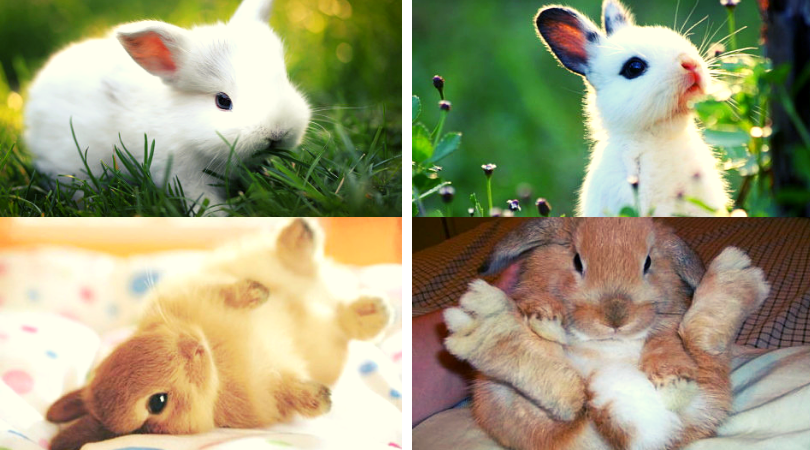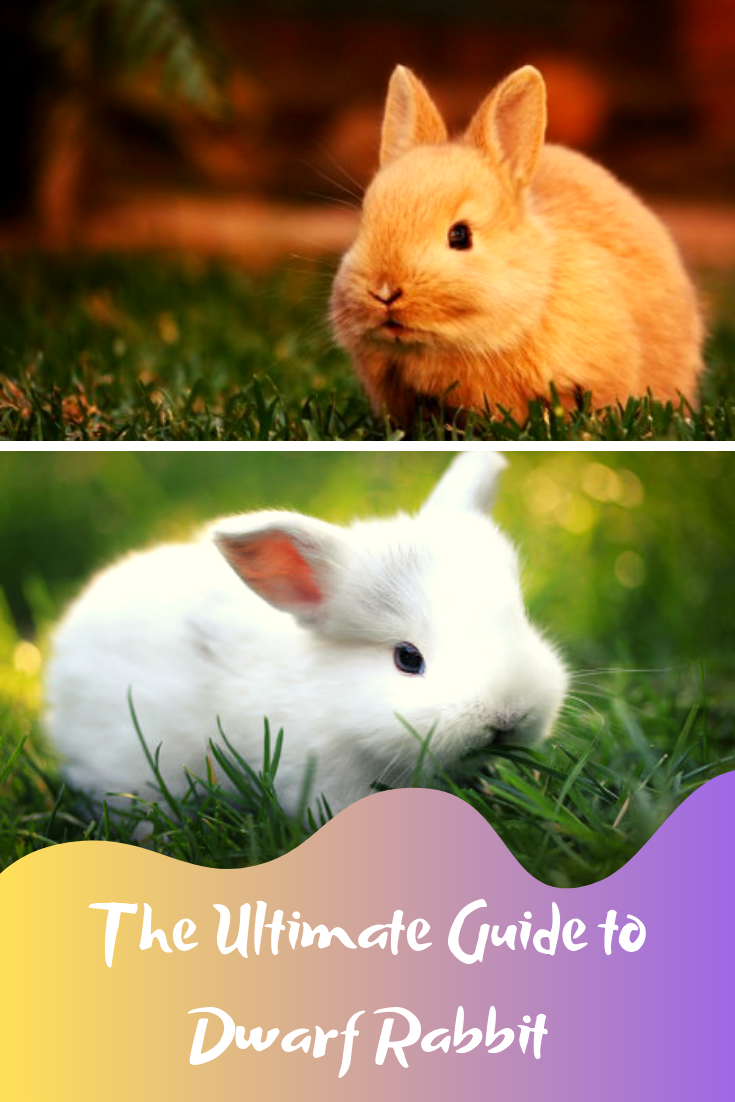So, why dwarf rabbits? Well, the most obvious reason is because they’re so unbelievably adorable! Let’s see some of the most common dwarf rabbit facts. They are relatively low maintenance, are quite sociable, and, compared to say dogs or cats, have a much more mild temper. Dwarf rabbits love to chew things, which is quite necessary for them to file down their teeth.
You can give your dwarf rabbit a lot of different things to chew on: wooden treats, cardboard rolls, old phone books, etc. Just be sure to keep an eye out on your dwarf bunny, if you’re leaving them out in an open place, because dwarf bunnies will chew through wires of all sorts!
Dwarf Rabbits Size
The most obvious feature of Dwarf Rabbit is their diminutive size. They’re so cute when they’re young! You could fit them in the palm of your hand. Full grown, they average 2-2.5 pounds. Dwarf bunny fur is incredibly soft and glossy, and dwarf bunnies are commonly displayed for show.
Dwarf Rabbits Colors
You can get a dwarf bunny in several colors, including: black, grey, chocolate, silver, and tan, and dwarf bunnies can come have several eye colors, including red and blue.

Dwarf Rabbits – Care
Although Dwarf rabbits do not require any complicated care system, theoretically keeping them should only be entrusted to experienced people. Dwarf rabbits are infection vulnerable and mischievous and, therefore to diligently care for them is necessary.
The enclosure requires regular cleaning. That will help to prevent foot sores and infection. The cage must provide enough space for the rabbit to feel loose and free to occupy any suitable position.
Types of Dwarf Rabbits:
- Netherland Dwarf Rabbit
- Dwarf Hotot
- Jersey Wooly
- Britannia Petite
- Polish
- Mini Rex
Netherland Dwarf Rabbit
As can be derived from the name, Netherland Dwarf Rabbits originated from the Netherland and its size is much smaller than other breeds of rabbits. It is available in a variety of colors owing to the fact that it is a cross breed of some wild rabbits and Polish rabbits. While it originated in the Netherlands currently all over the world there are Netherland Dwarf Rabbits for Sale.
Polish Dwarf Rabbits
The Polish Dwarf is a bit bigger than the Netherland Dwarf. Polish Dwarfs have rather short ears. They are extremely active and they can do a lot of tricks and things without getting tired. Polish Dwarfs are very trainable and sociable; they take to their owners pretty fast. They can be white, black, blue and chocolate in color. White rabbits can have ruby and blue eyes.
Dwarf Rabbits – Mini Rex
Mini Rex is relatively a new breed. The progenitor of the breed is Monna R. Berryhill, who crossbred a Dwarf Rex buck with a small sized Lynx Rex doe. In 1988, the American Rabbit Breeders Association (ARBA) registered the new breed and that was the beginning of the Dwarf Rex breed.
The Mini Rex is known for its soft and velvety fur. The average weight is 3.5-4.5 lbs. They may come in Tortoise Broken, seal, Lilac, Lynx, Red, White (red eyed), Chocolate, Chinchilla, Castor, Opal, Black and Blue.
Hotot Dwarf Rabbit
Pronounced Ho-Toe, the Dwarf Hotot Rabbit is quite active and gets along well with humans. Dwarf Hotot rabbits grow to weigh about 2.5 – 3 pounds, with a size comparable to other dwarf bunnies. Dwarf Hotot bunnies are easily recognized by their all white coat, and a black ring around their eyes. They should have no noticeable neck.
Dwarf Hotot’s live about 7-10 years. Compared to other dwarf rabbit breeds, dwarf Hotots are pretty uncommon. The best dwarf Hotot bunnies will have an extreme contrast between their eye color and the fur color, literally black and white.
Jersey Wooly Dwarf Rabbit
Not much information can be found on the jersey Wooly dwarf rabbit. They are originally from Holland, and can be found at several breeders through the US. They come in several colors, and are recognized by their incredible coat, which, if you can picture it, reminds you of a Wooly mammoth coat on a dwarf rabbit body.
Britannia Dwarf Rabbit/Polish Dwarf Rabbit
There are 2 different kinds of Polish Dwarf Rabbits: the Britannia aka the British Dwarf Bunny aka the Polish Dwarf Rabbit, and the American Polish Dwarf Bunny.
Britannia Rabbits are all white with red eyes, but there are many other color combinations available. The 2 polish dwarf rabbit types are generally the smallest of the dwarf bunnies, and are highly regarded as being among the most intelligent dwarf bunnies.
However, the Polish Dwarf Bunny is very active, and, depending on breeder, can be irritable and just all around unpleasant. It is important to note that often this is breeder error, and inherently the Polish Dwarf bunny is often sought after for being a wonderful pet or show rabbit. Polish Dwarf Rabbits often live 8-10 years.
American Polish Dwarf Rabbit
The American Polish Dwarf rabbit is slightly larger than the Britannia Dwarf Rabbit, and come in black, blue, and chocolate, with the same color eyes, and white with red/ruby or blue eyes. Overall however it shares many of the same characteristics as its UK brethren.
Giving the Dwarf Rabbit a Home
Dwarf rabbits usually don’t need an large place to live. Two or three cubic feet will usually suffice. There are many different things you can buy for your dwarf rabbit: for instance, a normal cage or a large hamster cage, or a hutch that you can get at a pet store. Can be as cheap as $10 or as much as $150, only depends on your budget.
The temperature environment of your dwarf bunny should not exceed 80 degrees farenheit. Dwarf bunnies can keep themselves warm, but have a hard time cooling themselves off. Should the temperature exceed 80 degrees, place a frozen water bottle in the dwarf bunny’s cage. This will help the dwarf bunny stay comfortable.

What Do Dwarf Rabbits Eat
Contrary to popular belief, feeding your dwarf rabbit carrots all the time is NOT recommended. The most widely recommended diet is a pellet diet. If you’ve raised another type of animal, you should know how important it is NOT to overfeed your dwarf rabbit. Resist it as much as you can! Everyday, feed your dwarf rabbit the recommended serving size recommended by your pellet manufacturer.
Find a nice, high quality feed. Freshness is also important. Dwarf rabbit feed should not be more than 8 weeks old. It seems obvious, but make sure that there isn’t any mold or anything growing in the feed bag. Also, different pellet brands have different composition makeup.
Pellets are generally designed for commercial use, so your pet dwarf bunny may get incredibly fat if you don’t purchase the correct type of pellet! Generally, try to find a low-fat low(er) protein pellet brand, or one designed for pet dwarf rabbits.
You can also feed your dwarf rabbit greens, but keep it a reasonable amount. If you’re just starting out feeding your dwarf rabbit greens, let them adjust to it slowly. Their droppings may be a little bit softer while getting used to these greens.
Treats should be used sparingly. Treats are great for creating a bond between you and your dwarf bunny, but don’t overdo it! You could have one very, VERY large dwarf bunny if you feed him too many treats, and that would totally defeat the purpose of getting a dwarf bunny now wouldn’t it? Use treats sparingly, but definitely use them!
Also, be certain to leave plenty of water! I would recommend the use of a gravity type water feeder, most commonly seen on hamster cages. I’d stay away from water bowls and the like because your dwarf bunny may hit it, causing water to get all over the cage.
A Note About Hay
Hay is very important to your dwarf rabbit’s diet. Hay contains fiber and other „stuff“ which helps with the dwarf bunny’s digestive system. Give your dwarf bunny a little bit of hay everyday.
Your Dwarf Bunny’s Behavior
Is your dwarf bunny kept in its cage 24/7? If it is, then you need to rethink your dwarf bunny’s environment. Dwarf bunnies need room to roam around and explore, and more importantly, exercise! An hour or two a day goes a long way in your dwarf bunny’s happiness.
If you have more than 1 bunny, make sure the male dwarf rabbits are neutered! If there’s more than 1 unneutered male, well, prepare for some dwarf rabbit fight club! Female rabbits are usually fine. If you have 1 male and 1 female, make sure the male is neutered. Female dwarf bunnies can breed every 28 days if they were so inclined. Otherwise, dwarf bunnies make great companion animals, and can make great pets for children.
Dwarf Rabbits – General Physiology
Dwarfs have some common physiological characteristics. The body temperature ranges from 37.5 to 39 degrees Centigrade. Heart race is frequent. It covers 150-300 beats per interval. Life span is common to all breeds of rabbits (including regular rabbits). Dwarf rabbits live 5-8 years.